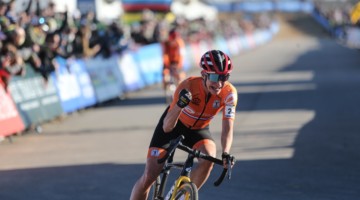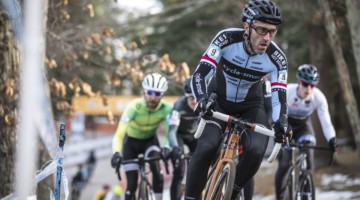Racing in the off-season? You’re not alone. In an earlier post, Adam Myerson acknowledged the value of training races, but only if actually used as training races. However, let’s say you’ve already put your training time in, and are ready for some results on that strange surface we call the pavement. Myerson lays out a plan that entails racing to your strengths, but preparing for your weaknesses. While the following advice includes picking specific road races to play to strengths, much of the training information is just as relevant to gravel racing and cyclocross. You can find other training ideas and articles at cycle-smart.com, as well as information on internationally-recognized coaching and clinic programs for all skill levels.
by Adam Myerson
By the month of May, most North American riders are done with base training for their summer season, or very close to it, and have anywhere from 1-3 months of racing under their belt. If you’ve had a successful spring, you should have a strong foundation of aerobic fitness, with the ability to ride at race pace for up to 60 minutes, enough endurance to finish your longest races, and the capacity to recover quickly from interval work and consecutive training or racing days.
This is also the point where you should have enough information to sense what you’re doing well and what you’re doing poorly. Have you been climbing well? Sprinting well? The opposite? Are you finding that you’re OK on climbs of 1-5 minutes, but are getting dropped on anything longer than that? Whatever the situation, with feedback from your racing performances, this late-spring period is the perfect time to try to address any weaknesses. At the same time, it’s important to recognize where you’ve been successful, and take that into consideration when you make tactical choices in your races, or even what races you choose to enter.
Your first order of business is to attempt to define your skills, both in terms of energy systems and modes of riding or racing. I’ve discussed energy systems many times before in my articles, so I don’t want to spend too much time on it here. Generally, you want to consider the following areas in which you may be strong or weak, remembering that they’re all interconnected to some degree:
- Peak Power
- Average over 8-15 seconds
- Maximum or peak/instantaneous power
- Anaerobic power and work capacity over a 1-minute period
- VO2max power over a 3-5-minute period
- Threshold power over a 20-minute period
- Tempo over a 30-60-minute period
- Endurance over a 3-6-hour period
Additionally, you want to consider the way you train in these zones or for these durations. How do you actually apply the power? Consider the following modes or skills you may want to identify:
- Climbing
- Sprinting
- Time Trialing
- Variable Power/Criteriums
- Other (Stage Racing, MTB, ‘Cross, etc.)
How then, with these parameters, to determine your skills, and specifically your strengths and weaknesses? The first factor, certainly, should be race results. On one hand, results don’t tell the whole story. They only put a number next to your name, with no room for an explanation. It doesn’t say “6th place, but…” However, results are the synthesis of all the training you do and tactics you employ, and if you a have a large enough pool of results, patterns emerge.
If you have the benefit of also looking at power data from races, then you can see even more closely what you’re doing well or poorly when you combine that with the outcome of the race. Lab testing is another way to identify physiological characteristics. Tests that allow you to measure efficiency, power output at lactate and aerobic threshold, VO2max, and maximal power can give you a profile of your abilities and allow you to compare yourself to other athletes.
Training itself is also testing if you’re using a power meter. Observing the power you can generate over a 20-minute interval and tracking that progress from week to week, for instance, will let you know how well you’re improving, and if that’s a card you have to play in the races or a weak spot you have to conceal. Two other important keys to determining your strengths and weaknesses are simply time, and your own mentality. The longer you’ve been at it, the more you’ll get a sense of your skills. At the same time the mindset you bring to the races will often determine what you’re capable of. It doesn’t matter if you make exceptional peak power if you don’t have the head for the dangers of a field sprint.
The simple approach to becoming a better rider is to train all aspects, at first. If you can improve your basic fitness level, you’re going to be at the finish more often, and have more left at the critical moments of a race to use the specific strengths you might have. From there, you may have some personal racing goals that will drive you to patch the holes in your form. If you’re a strong rider who really likes crits but is missing something out of the last corner, you may decide to focus on improving your peak power.
Conversely, if you’re a fast rider who wants to win road races, you know you’re going to have to improve your climbing well enough to get over the hills or make the break in order to use that natural sprint ability at the finish. Your local racing schedule may push you to work on weaknesses as well. If you’re not a great climber but all you find on your local calendar in the early part of the season are hilly road races, well, you’ve got a clear choice in front of you if you want to finish races.
For many of those same reasons, though, you shouldn’t be afraid to buck the norm and train your strengths. Perhaps you’re not a good climber, and you simply don’t enjoy doing that kind of training,or suffering through hilly road races to try to improve at the risk of being dropped. There’s absolutely nothing wrong with attempting to achieve your potential in one specific area, specializing to the point where perhaps you only enter crits or even turn to the track. Conversely, you may love to climb and really want to specialize in that, focusing on races like Mt. Washington, or road and stage races that put climbing at a premium. Most of us are doing this because it’s fun, so why not focus on the training that’s enjoyable to you? Personally, I found more success in my career when I stopped going to races that I knew didn’t suit me, and focused on the ones that did.
Even if you’ve identified your weaknesses and chosen to work on and improve them, you still have to go into each race knowing what your best skills are and how to utilize them for a good result. Your tactical approach has to revolve around your strongest suit. That may mean banking on a field sprint and doing absolutely nothing until the last 5 or 10 laps of a crit. It may mean letting all the early attacking and counter-attacking go on without you, saving it for your one big attack on the final climb. It may mean making the early break and counting on your endurance to survive a race of attrition. Whatever it is, make sure you’re clear on your best scenario for winning, and try to play the race in that direction.
Choosing your races in the first place is another aspect of this, as I explained in the approach you might take in training your strengths. If you’re a skinny guy who can’t turn, you might decide to save your energy for the races you enjoy and can have an impact in. If you’re a pure sprinter who can’t climb with your peers regardless of how much you’ve worked on it, skip those hilly road races if getting results is your first priority and you don’t need to use them for training. Setting reasonable expectations based on your skills is an important part of staying sane in this sport.
Training your weaknesses but racing to your strengths is a simple approach that will lead to noticeable improvement in most riders, though it can be more easily said than done. It’s tricky business trying to isolate what your weaknesses are, and often riders mistake weakness in one area for another. If you’re getting dropped on the climbs, you might assume that you need more VO2max power to hammer up those 5-minute hills, whereas in reality, you may be struggling because your threshold power is too low compared to your peers, and you’re over your limit much sooner on a climb than you should be. Along the same lines, you may be getting popped on the last lap of a criterium and think your weakness is peak or anaerobic power, when again, the issue is low threshold power putting you in the red too soon, and out of the sprint before you can even show your speed. Threshold power really is the foundation from which you can build all your other skills. Strengthen that area first, make sure it’s solid, and then begin to think about fine-tuning the other areas for overall good form and successful results.





























